Alternator Drive Belt Replacement
in the DOHC Mitsubishi 3000GT/Dodge Stealth
by Jeff Lucius
Introduction
The drive belt for the alternator and AC compressor (if installed) should be replaced every 30,000 miles or 3 to 4 years, or if it shows signs of wear. These instructions supplement the instructions in the service manual for replacing the alternator and AC compressor drive belt in the DOHC Mitsubishi 3000GT and Dodge Stealth. The tools and supplies required are a hydraulic jack, jack stands, two wheel chucks (blocks of wood are fine), lug wrench or the appropriate socket and ratchet for your wheels, a torque wrench that goes up to 100 ft-lbs, a small flat-head tool for some Stealth owners to remove the wheel center cap, 10-mm, 12-mm, 14-mm, and 12-mm-deep sockets and ratchet (a swivel head ratchet may be required), 3" and 6" socket extensions, six feet of cord, and safety glasses (for working under the car). The alternator with AC drive belt for the DOHC engine is MB879764. Its list price is $27.70 but can be purchased for $20.78 from Tallahassee Mitsubishi and other discount dealers (see a list and contact information on my Garage Page). Please read through all the instructions before starting this procedure. The work below was performed on a 1992 Dodge Stealth R/T Twin Turbo with custom intercooler piping.
Removal
1. Disconnect negative battery cable. With the ignition off, remove the negative battery cable from the battery. Be sure you have security codes for any devices that might need them before you do this.
2. Lift and support car, remove wheel. You must remove the driver's side front wheel to gain access to the alternator drive belt tensioner. I have some tips for lifting and supporting the car at my web page 2-raisecar.htm and removing the wheel at my web page 2-tirerotation.htm. Generally, you want to loosen the wheel lug nuts a little, lift the car, rest the front cross member near the rear of the control arm on a jack stand, and finish removing the wheel. Be sure the car is securely and safely supported before you proceed.
3. Front splash shield. Remove the three tapping screws, the two 10-mm bolts, and the five clips with screws from the plastic splash shield in front of the wheel well. The clips with screws are removed by uncsrewing the screw part a little then pulling the whole clip out. If the screw does not want to back out, then try putting a little upward pressure on the grommet by lightly prying around the base with a small screwdriver.
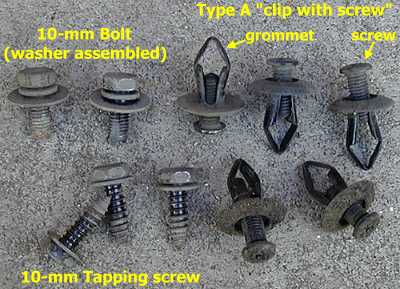
4. Engine room side cover. This cover is behind the driver's side front wheel and conceals the belts and pulleys. Remove the two clips with screws on the bottom and the three 12-mm bolts near the top of the side cover. Set the side cover out of the way.
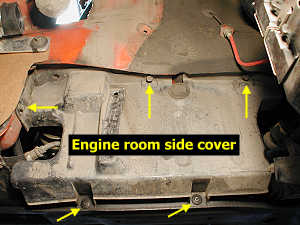
5. Tensioner pulley and drive belt. Before adjusting the tensioner, take a moment to note the tension on the belt between the idler and crankshaft pulleys as shown in the figure at the end of the web page. Loosen, but do not remove, the 14-mm bolt in the center of the tensioner pulley. With a 12-mm socket, rotate the tensioner bolt counterclockwise to lower the pulley and reduce tension on the belt. Stop when the belt is loose enough to remove. If you plan to re-use the drive belt, then mark the outer edge of the back of the belt (flat side) with chalk so that you can re-install it the same orientation. Note how the ridges in the belt fit in the grooves of the different pulleys.
Work the drive belt off the pulleys. the belt will have to be turned "sideways" to get it between the AC refrigerant lines and the alternator pulley. If you cannot get the belt off from below you will need to gain access to it from above by raising the AC suction line and removing some intercooler piping. For the air conditioning suction hose, remove the two 10-mm nuts toward the back, the 12-mm nut on the side, and the 12-mm bolt at the front. Lift the hose until it no longer moves easily and tie it off to the hood using a cord.
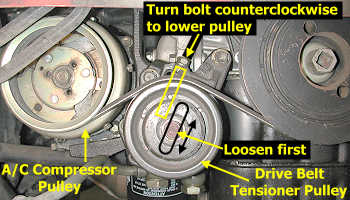
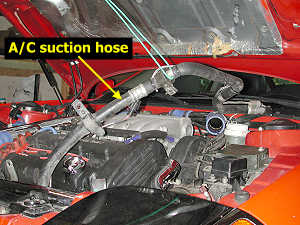
Installation
If you cannot install the belt from below then insert the belt from above after raising the AC suction line and removing an IC pipe or two. Turn it "sideways" to fit it in between the alternator pulley and the AC pipe. Correctly tension the drive belt using its tensioner pulley. Before installing the plastic covers and wheel, temporarily install the IC pipes if removed and the battery negative cable and start the engine to check the belt operation. If the belt squeals it is either misaligned or too loose. If you have messed with both drive belts, spray a little water on one belt at a time to see which is squealing. A misalligned belt will stop squealing for a very short time after water is sprayed on it, but the squealing quickly comes back louder than before. If the belt is loose, the squealing will immediately get louder. Also note that there is just a little play in how the alternator bolts in. If misalignment is a problem, loosen all four bracket mounting bolts on the alternator (this may require again removing an IC pipe, more details about the alternator on my web page concerning alternator removal), reposition the alternator, and tighten the bolts to see if this helps. Do not tighten the belt too much because this can lead to shaft bearing failure over time.
Here are some links concerning drive belt adjustment.
http://www.gates.com/brochure.cfm?brochure=1026
http://www.ridgeap.com/tips/the_charging_system1_2.htm
http://www.utfleets.com/library/features/accessory_drive_belts.htm
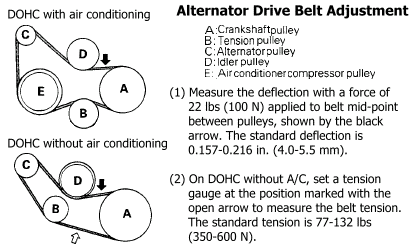
After you are satisfied the drive belt is installed correctly, disconnect the battery negative cable and re-install the other parts. Tips for mounting the wheel are on my web page 2-tirerotation.htm. The last thing to do is re-connect the negative battery cable.
Page last updated November 17, 2003.





